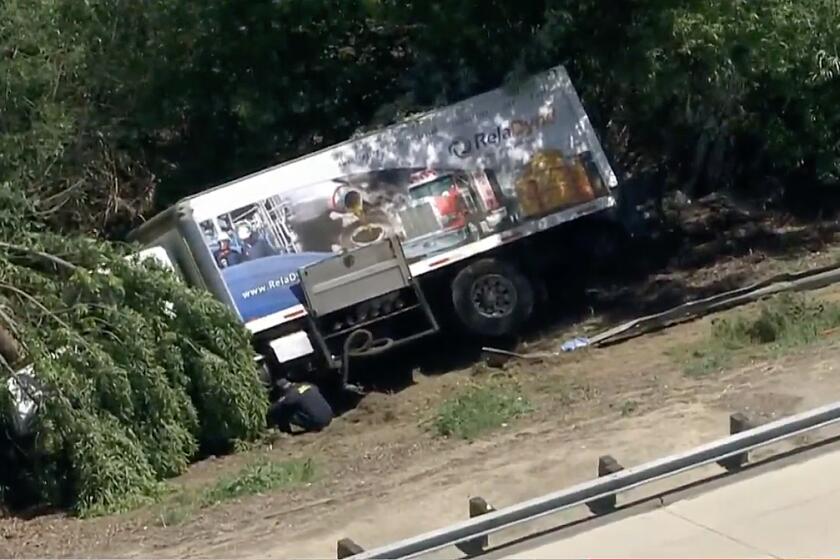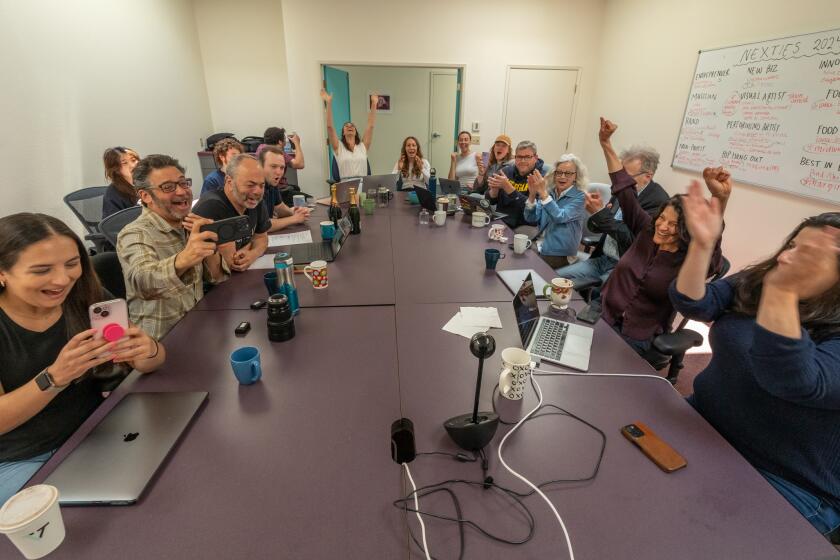COLUMN ONE : A Humble Symbol of the ‘90s : Self-storage warehouses are booming. Newly homeless stash their belongings there. Small firms set up shop to save on rent. Then there’s the guy seeking a refuge to smoke his cigars.
The recession cut Roy Cipollaro’s mail order business by more than half so he closed his office and laid off his secretary. He was able to stay in business by renting space in a self-storage warehouse, installing phone and fax lines and setting up a stripped-down, low-cost office.
The surroundings are stark--concrete floor, walls made out of aluminum sheeting and metal roll-up door with a padlock. But the rent--$250 a month--is a bargain in West Los Angeles, compared to the $1,500 a month he paid for his previous office.
“This place doesn’t have many amenities--it doesn’t even have carpeting,” Cipollaro said. “But if I had stayed where I was, I’d be out of business by now.”
While huge, lavishly appointed offices in tony downtown towers symbolized business during the 1980s, the lowly self-storage warehouse may come to symbolize the debt-laden, bottom-line ‘90s.
Overhead cutting by businesses is only one reason self-storage warehouses are thriving. About one in five Californians move every year, and even the flight of residents out of state has benefited the facilities. Families often stow their belongings in lockers and return to pick them up after they are settled. During the recession, new uses continually are being found for the spaces.
An increasing number of recently homeless people store their possessions in self-storage lockers. Officials at Public Storage in Hollywood say about 200 homeless people rent storage space. Many, living in cars or on the street, have nowhere to store their belongings, so they pay $29 a month for a 5-by-5-foot storage space, “until they get back on their feet,” said manager Frank Stevens.
At one time, self-storage businesses were just primitive warehouses, with no electricity or insulation, located in industrial areas on the outskirts of town. But many facilities now are being built in residential areas and have climate-controlled spaces, fax machines, 24-hour access and security systems that include motion detectors and video scanners. Self-storage has evolved into a sophisticated $2-billion-a-year industry nationally. The number of facilities has tripled in the last decade, from 8,000 to about 25,000, said John Baragona, editor of Inside Self-Storage, a trade magazine for the industry.
“Business has been booming for a while, but the recession has created even more customers,” said Fernando Viciconte, associate manager of Figueroa Self Storage in Los Angeles. “We’re renting to a lot of families who lost their houses through foreclosure and to people who’ve moved into smaller apartments to cut their rent. In our Westwood facility we’ve even got a lady that drives up in a new Jaguar . . . who had to sell her house and had nowhere to store all her things.”
*
Families and businesses that need extra storage space still are the warehouses’ best customers. But people now rent space for such peculiar reasons that Inside Self-Storage runs a feature every month called “The Lighter Side.”
A man in Olympia, Wash., rented a space because he liked to smoke a cigar after dinner and read the paper, but his wife could not stand the smell, recalled Tim Riley, director of marketing for Shurgard Storage Centers. So the man moved his favorite chair into his space, and every night after dinner he visited the warehouse, smoked his cigar and read the newspaper.
A middle-aged woman in Texas rented a space, Riley said, because she wanted to learn to roller skate but was afraid of appearing ridiculous. So she practiced on the concrete floor of her space until she felt comfortable enough to skate in public.
A couple in San Diego, who were having an affair, were afraid of being spotted at motels so they rented a space for lunchtime trysts. They outfitted it, according to the manager, with a mattress, a lamp with a dimmer switch and a stereo system.
A number of connoisseurs in San Francisco have created wine cellars, and artists in San Diego are setting up studios in the spaces because they are cheaper than lofts. In Los Angeles, movie studios are storing props and costumes in self-storage warehouses near where they are filming.
Drug dealers, murderers and thieves also take advantage of the anonymity of self-storage. Large caches of marijuana have been found in Los Angeles facilities, and sophisticated methamphetamine labs have been raided in Inland Empire warehouses.
About once a month a body is found in one of the nation’s storage facilities, Baragona said. At Public Storage in Hollywood, the body of a 29-year-old man was recently discovered partly encased in concrete inside a refrigerator. The body might never have been discovered but the killers made a critical error--they closed the refrigerator door before the concrete was dry. This allowed the body to decompose, and the odor tipped off management.
*
Near downtown Los Angeles, Julie Crawford is one of about a dozen homeless people who store their belongings at Figueroa Self-Storage. Crawford, 74, was released from a hospital after a stroke last year and could not get her job back as a nurse’s aide. She receives about $600 a month from Social Security and if she rented an apartment, she would have very little money left for food, she says.
So she sleeps in her battered 1977 Ford Maverick and visits the storage warehouse daily to change clothes or pick up blankets when the temperature dips, or just to sort through her belongings when she feels lonesome and wants to be surrounded by familiar things.
On a recent morning, after spending the night parked on a side street, she drove up to the warehouse. Crawford pulled some cosmetics out of a paper bag and, using her rear-view mirror, dabbed her lips with pink lipstick and applied some rouge. Visiting the space each morning is an important ritual and she tries to “freshen up,” she said.
Her space is filled from floor to ceiling with boxes, neatly labeled: “Pink Dishes,” “Sewing,” “Pots,” “Lamps.” She removes a sweater from one box and returns to her car. Once or twice a week she stays at a friend’s house, where she can shower and wash her clothes. But most of the time she parks in the warehouse lot, writes letters, reads magazines and naps.
“I guess you could say this is my home now,” she said. “I don’t like it, but I’m a survivor. And this is what I have to do to survive.”
Viciconte, the associate manager of the warehouse, said he has to stay vigilant because homeless people are constantly trying to sleep in their spaces, which is illegal. Viciconte is interrupted by a woman with a spider tattoo on her wrist, a black leather jacket and blue-black hair, who walks in and pays the rent in cash. She is the bass player for an all-woman rock group, “Duchess DeSade,” one of about half a dozen bands that rent rehearsal space at the facility.
*
A number of firms throughout Southern California have begun devoting a handful of spaces at their warehouses to office use, said Greg Call, president of a company that manages 25 self-storage warehouses in Southern California. But because the concept is relatively new, he said, there is great room for expansion.
At one of Call’s warehouses, American Mini Storage in Marina del Rey, Danny Bental recently set up his computer graphic and film service office. Bental decided to move to the self-storage unit after he visited commercial offices, where the rents were much higher and a long-term lease was required. Although American Mini Storage looks like a typical concrete-block warehouse, Bental’s office is well appointed, with track lighting, carpeting and stucco walls with pictures of sailing ships.
“If we were in an expensive office building, like some we looked at, with 11-page leases and high rents, there would be a lot more pressure on us,” he said. “We’re a new company and trying to make it, so this is an alternative that makes sense.”
For companies that do most of their business by phone and have few walk-in customers, self-storage facilities are an ideal way to cut overhead, said Nyle Dupont, general manager of Safeway Self Storage in Los Angeles.
“The office business is something we’re definitely trying to cultivate--we see a lot of potential in that,” Dupont said. “We’re sending out flyers now and letting businesses know that they can save a lot of money with us.”
In Los Angeles, designating a number of office spaces at a self-storage warehouse is a simple procedure, said Hector Buitrago, zoning engineer for the city Building and Safety Department. The owner has to apply for a change-of-use permit, which is contingent upon providing sufficient parking and features such as handicapped access and additional exits. The department does not visit warehouses “looking for violations, unless we receive a complaint,” he said. There are no statistics available on the number of facilities that have applied for such permits.
As the self-storage business has expanded, more firms have attempted to build facilities closer to residential areas, where architectural standards are higher. As a result, developers are coming up with innovative designs for the once blocky eyesores, said Greg Ottersbach, publisher of the Mini-Storage Messenger, a trade publication. The magazine gives an award every year to the facility judged to have the most impressive architecture.
One recent winner was a Shurgard Storage Center in Seattle designed to look like a row of English townhouses, with brick facades, gables and bay windows. Another Shurgard warehouse, in Culver City, has the look of a typical Westside hotel, with pastel-colored stucco and tile, flower boxes under the windows and a row of palm trees in front.
At Tarzana Self Storage, warehouses are covered with huge, intricately sculpted artworks featuring bas-relief mountains, rainbows, undulating waves, pale blue cloud patterns and trapezoidal windows. After a number of plans for the facility were rejected by community groups and the city, the developer contacted Gary Soszynski, a Woodland Hills artist. His unusual design was quickly accepted.
“At one time, self-storage was just a bunch of tin cubicles in the middle of some empty fields,” said Viciconte of Figueroa Self Storage. “But the business has evolved so quickly and become so sophisticated that it’s not just a storage business anymore. The uses for the spaces now are only limited by the imagination of the people renting them.”
More to Read
Start your day right
Sign up for Essential California for news, features and recommendations from the L.A. Times and beyond in your inbox six days a week.
You may occasionally receive promotional content from the Los Angeles Times.






